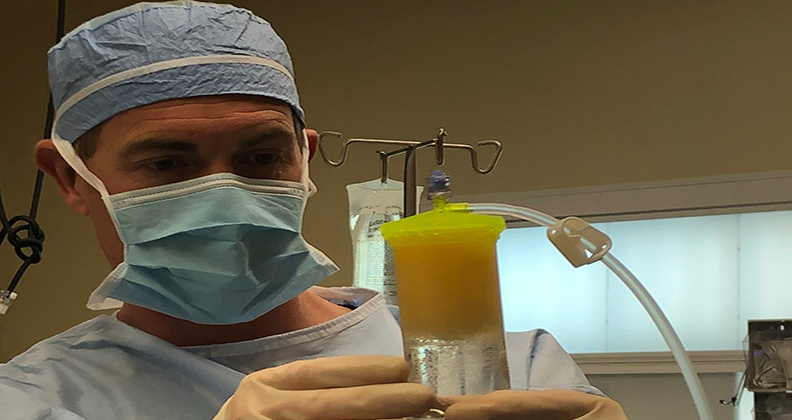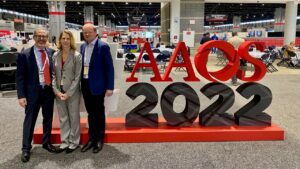
The orthobiologics field is known for rapid scientific progress. It’s against this backdrop that startup strategist Carl Llewellyn successfully launched Lipogems in the U.S. The adipose tissue technology that was created in Milan, Italy, is used to harvest, concentrate and transfer a patient’s own fat for the repair, reconstruction and replacement of injured or damaged tissue.
In October, FDA awarded Lipogems a second Investigational Device Exemption (IDE) study for the treatment of knee osteoarthritis (OA). It’s the next step in a nine-year journey for Llewellyn and the Lipogems team that began in 2014 when the product received FDA clearance for a broad indication that covered lipofilling for orthopedic surgery and nine other specialties.
Llewellyn and his team could sell Lipogems for general applications, but wanted to market the treatment with a specific indication for treating knee OA. He reached out to Scott Bruder, M.D., Ph.D., an old friend who had founded Bruder Consulting & Venture Group (BCVG) to help companies navigate from ideation to commercialization in the orthobiologics space.
Lipogems has already been used in more than 50,000 cases worldwide, but securing FDA approval for use in treating knee OA and insurance reimbursement in the U.S. would be a game-changer for the product’s market access and promotion. Llewellyn said collaborating with BCVG’s team was imperative in developing a strategy that led to the IDE study.
Dr. Bruder’s team of professionals boasts diverse backgrounds and expertise and has completed more than 500 projects for over 100 clients. They play a comprehensive role in the development of regenerative medicine products, from regulatory matters to strategic planning and commercialization. They also handle all aspects of product manufacturing, the design and execution of preclinical studies and the management of regulatory filings.
BCVG’s efforts to help bring Lipogems to market and work toward securing reimbursement for the OA indication provide a blueprint for navigating the product development pathway in orthobiologics, a field full of tremendous growth potential and plenty of possible pitfalls.
Speaking the Right Language
It’s vital to engage FDA as early as possible in a product’s development to determine the best path forward, according to Susan Drapeau, Ph.D., Vice President of Product Development and Commercialization at BCVG. “Some companies approach us to file a Request for Designation (RFD) for a new therapy,” she explained. “However, upon reviewing the data, we often find that this may not be necessary.”
Instead, she said, they suggest a more direct path that aligns with the intended regulatory approach through a pre-submission or pre-investigational new drug application, which could expedite the regulatory review process by three to six months.
Companies with novel product concepts should conduct early reimbursement assessments, according to Dr. Drapeau. She also recommends a proactive approach to defining a product’s target product profile and claims matrix. Doing so helps identify claims to substantiate during preclinical trials and later in clinical settings.
“It’s not an expensive undertaking and provides an early assessment of what companies could achieve in the reimbursement landscape,” Dr. Drapeau said. “During the gathering of preclinical data, it’s important to compile evidence that demonstrates the product’s potential benefits in animal models. This early proof paves the way for a smoother transition into human studies, ensuring the collection of robust and valuable data.”
FDA’s requirements for orthobiologics can be unclear and somewhat unpredictable, which is why companies need to work with firms that possess regulatory experience. BCVG’s previous interactions with the agency revealed a clear path forward for Lipogems.
“We were transparent and clear about our intentions and actions when we approached the agency with Scott,” Llewellyn said. “After opening the channels of communication, it became apparent that FDA had defined protocols in place that were outlined in its policies and Guidance Documents.”
Early during Lipogems’ development, Llewellyn hesitated to pursue a knee OA indication, concerned it could necessitate an Investigational New Drug (IND) classification in addition to the approval the treatment already had. Following a series of successful 510(k) clearances from the Center for Devices and Radiological Health (CDRH), subsequent conversations with FDA clarified that in the setting of knee OA the product should still be categorized as a device, not a biologic. That the Center for Biologics Evaluation and Research (CBER) would still lead the IDE and PMA review was an interesting twist to the FDA journey and an important outcome for Llewellyn.
“Scott was the first to approach FDA’s Tissue Reference Group Rapid Inquiry Program (TRIP) to define our knee OA pathway,” he said. “The BCVG team was instrumental in confirming and defining with the agency that the Lipogems device and process involves a transfer of structural tissue. They helped the agency recognize this distinction.”
Dr. Bruder said his team often finds themselves in the role of educators, not only for FDA and CMS but also for those involved in reimbursement decisions.
“We essentially guide clinicians, group purchasing organizations and other decision-makers on a product development journey for which well-defined clinical standards might not exist,” he said.
Proactive Approach
Companies must take a holistic approach to product development, always thinking two steps ahead to ensure current decisions have a positive impact on the overall scope of a project. BCVG’s insights are integrated across all disciplines, including clinical studies, health economics, regulatory affairs and intellectual property.
“The close-knit way we collaborate allows us to consider a comprehensive range of factors during the product development process,” Dr. Bruder said. “We think about reimbursement and commercial strategies during early regulatory and scientific decisions, including the animal studies needed to support regulatory approval. Our focus extends beyond regulatory requirements to the practical utility and the role these studies play in supporting eventual sales and serving as proof sources.”
The team designs clinical studies with the big picture in mind. “We don’t just think about what’s essential for regulatory approval but also what’s crucial for reimbursement,” Dr. Bruder said.
One member of the BCVG team helped design a statistical analysis method that allowed Llewellyn to enroll 173 patients in Lipogems’ clinical trial instead of the expected 285 patients. That’s a significant benefit for small startups, considering it costs at least $20,000 for each patient enrolled in knee OA clinical trials.
Conducting animal studies with materials that have never undergone a release assay isn’t the best strategy. It’s also a misstep to procure materials intended for use in a clinical trial without having a proper quality system in place. “These are significant shortcomings, especially for small companies,” Dr. Drapeau said.
Establishing a quality system can be challenging, but it’s an essential step when dealing with products destined for regulatory submission. Implementing proper manufacturing protocols and overseeing manufacturing facilities is also a daunting task for startups, as they often lack prior experience in this area. BCVG handles these steps for their clients as well.
“We demonstrate that working through the regulatory pathway will reap benefits when products enter the market,” Dr. Drapeau said. “While the development process may be longer and costlier, the eventual return on investment will be substantial in the long run.”

Scott Bruder, Susan Drapeau and James Petricek (left to right) bring diverse backgrounds and wide-ranging expertise to the integrated insights they provide.
Ready to Adapt
Llewellyn is drawn to the personal touch that the BCVG team provides and their commitment to ensuring a project’s success. “We’re able to be nimble and agile to meet the specific needs of each client partner,” Dr. Bruder said.
Case in point: Dr. Drapeau joined BCVG nearly two years ago, about the time Lipogems received questions from FDA related to endotoxin testing. She immediately took control of the situation and conducted preliminary testing in her kitchen. She performed installation and operational qualifications for all the instrumentation, developed the testing methodology and documented the entire process. Her final results were included in Lipogems’ FDA submission.
“An important part of our work is to maintain strong relationships with our client partners and do whatever it takes to meet their needs,” Dr. Drapeau said. “When they call on a Tuesday afternoon while I’m on my way to pick up my kid at school, I answer the phone. We can discuss endotoxin matters or any other concerns they have. It’s all part of the process.”
BCVG’s willingness to be transparent and forthright is a significant factor in the team’s success. “Unlike some consultants who deliver a polished product with minimal client interaction, we pride ourselves on our open and collaborative approach,” Dr. Drapeau said. “We believe in making our expertise and contributions available to every client.”
The team’s collective experience benefits the companies with which they work. “Many of us have been through the entire product development cycle,” Dr. Drapeau explained. “We’ve conceived, developed, launched and monitored products, gaining insights into what leads to success and understanding where challenges can occur.”
Staying Current
The orthobiologics market is dynamic, Dr. Drapeau noted. “It’s an area of great promise, and we’re excited about the potential it holds,” she said. “However, it will be essential to navigate the challenges and stay informed about emerging trends and regulatory requirements.”
To this point, Llewellyn recommends working with a team of experts who understand the orthobiologics market when launching innovative products. The many elements involved in bringing Lipogems to market are interconnected, and BCVG’s expertise along the way has been invaluable, according to Llewellyn.
“The team provided a single source of knowledge, which facilitated a cohesive approach,” he said. “This comprehensive perspective made the product development process much more manageable than it might otherwise have been.”
DC
Dan Cook is a Senior Editor at ORTHOWORLD. He develops content focused on important industry trends, top thought leaders and innovative technologies.




